Deep Learning-Based Denoising for Interactive Realistic Rendering of Biomedical Volumes
Abstract
1. Introduction
2. Related Work
2.1. Non-Linear Denoising Filters
2.2. Deep Learning-Based Denoising
2.3. Undersampled Image Denoising
2.4. Temporal Stability
2.5. Biomedical Image Denoising
3. Materials and Methods
3.1. MCPT Framework
3.2. Network Architectures
3.3. Image Generation
3.4. Dataset Preparation
3.5. Training Setup
3.6. Denoising on GPU
3.7. Quantitative Evaluation
3.8. Visual Assessment
4. Experiments
4.1. Training
4.2. Denoising Timing
4.3. Results Evaluation
4.4. Clinical Assessment
4.5. Temporal Stability
5. Limitations and Future Work
6. Conclusions
Supplementary Materials
Author Contributions
Funding
Institutional Review Board Statement
Informed Consent Statement
Data Availability Statement
Acknowledgments
Conflicts of Interest
Abbreviations
| LDR-FLIP | Low dynamic range foveated learned image perceptual |
| CBCT | Cone beam computed tomography |
| MCPT | Monte Carlo path tracing |
| OIDN | Open image denoise |
| PSNR | Peak signal-to-noise ratio |
| tPSNR | Temporal peak signal-to-noise ratio |
| SSIM | Structural similarity index measure |
| CPU | Central processing unit |
| GPU | Graphics processing unit |
| HDR | High dynamic range |
| MRI | Magnetic resonance imaging |
| MSE | Mean squared error |
| SPP | Sample(s) per second |
| AI | Artificial intelligence |
| CI | Confidence Interval |
| CT | Computed tomography |
| kV | Kilovolt |
| mA | Milliampere |
| ms | Millisecond |
| 3D | Three-dimensional |
Appendix A
| Architecture | Type | Layers | Parameters | Key Features |
|---|---|---|---|---|
| AE Lite | Autoencoder | Conv2D, MaxPooling2D, UpSampling2D, BatchNorm. | 52,451 | Lightweight architecture with minimal layers in encoder/decoder Pros: Fast training, low resource requirements Cons: May lack precision for complex denoising tasks in MCPT |
| AE Full | Autoencoder | Conv2D, MaxPooling2D, UpSampling2D, BatchNorm. | 188,675 | Larger model with deeper structure and repeated Conv2D layers Pros: Better performance on complex data Cons: Higher computational cost and risk of overfitting |
| Samsung | U-Net | Conv2D, Activation, Add, Concatenate | 683,907 | Multi-scale residual block, feature fusion, atrous spatial pyramid pooling (ASPP), dilated convolutions Pros: Advanced feature fusion, effective for complex noise patterns Cons: Computationally intensive, slow inference for real-time denoising |
| Tyan | U-Net | Conv2D, MaxPooling2D, UpSampling2D, Add, Concatenate | 10,918,915 | Deep encoding/decoding with dilated convolutions Pros: High accuracy for deep denoising tasks Cons: Long training times and large memory usage |
| OIDN | U-Net | Conv2D, MaxPooling2D, UpSampling2D, Add, Concatenate | 914,627 | Efficient upsampling with feature concatenation in multiple encoder/decoder blocks Pros: Efficient upsampling, suitable for real-time applications Cons: Limited in handling highly noisy datasets |

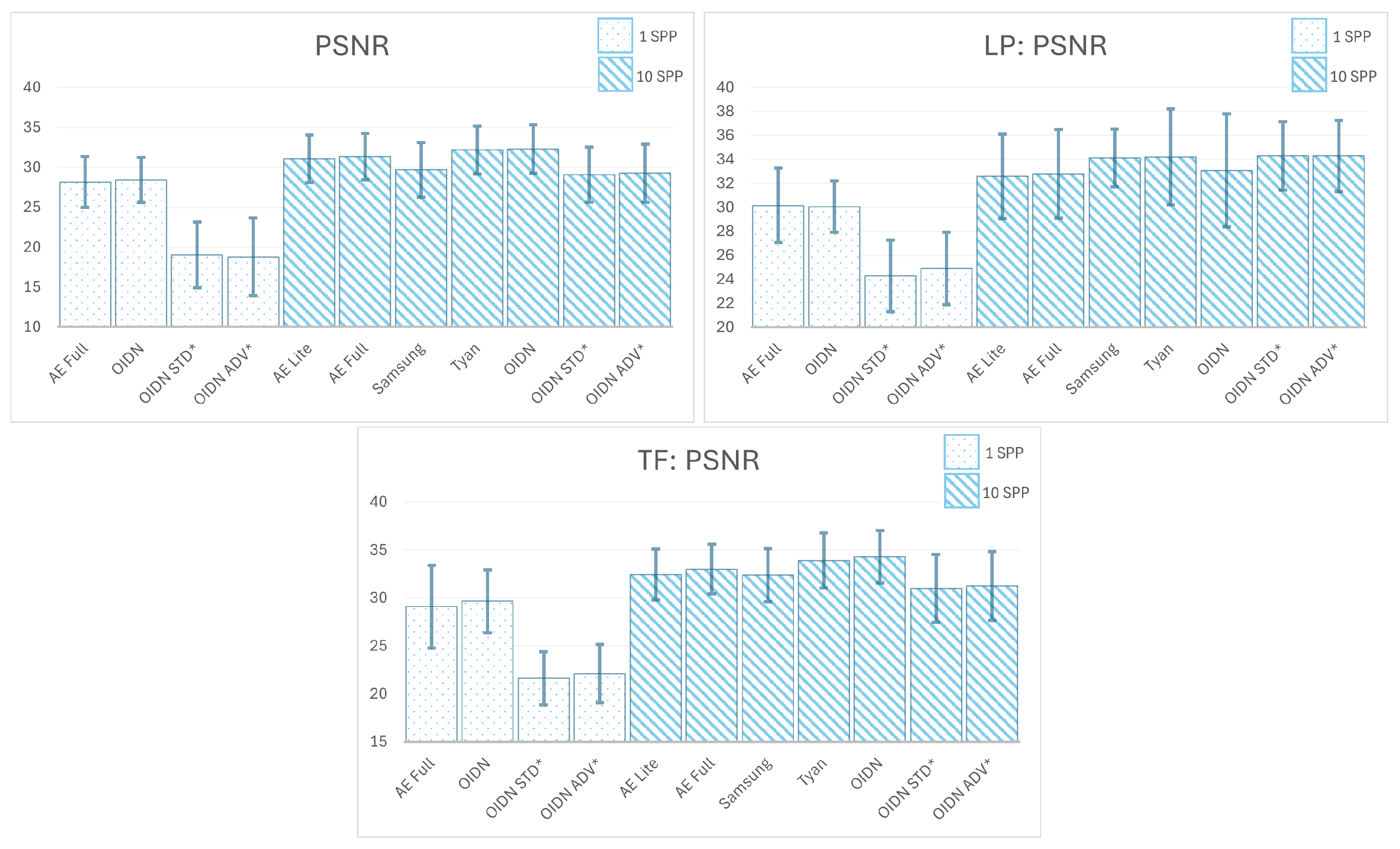
References
- Bueno, M.R.; Estrela, C.; Granjeiro, J.M.; Estrela, M.R.d.A.; Azevedo, B.C.; Diogenes, A. Cone-beam computed tomography cinematic rendering: Clinical, teaching and research applications. Braz. Oral Res. 2021, 35, e024. [Google Scholar] [CrossRef]
- Ebert, L.C.; Schweitzer, W.; Gascho, D.; Ruder, T.D.; Flach, P.M.; Thali, M.J.; Ampanozi, G. Forensic 3D visualization of CT data using cinematic volume rendering: A preliminary study. Am. J. Roentgenol. 2017, 208, 233–240. [Google Scholar] [CrossRef]
- Dappa, E.; Higashigaito, K.; Fornaro, J.; Leschka, S.; Wildermuth, S.; Alkadhi, H. Cinematic rendering—An alternative to volume rendering for 3D computed tomography imaging. Insights Imaging 2016, 7, 849–856. [Google Scholar] [CrossRef]
- Denisova, E.; Manetti, L.; Bocchi, L.; Iadanza, E. AR2T: Advanced Realistic Rendering Technique for Biomedical Volumes. In Proceedings of the Medical Image Computing and Computer Assisted Intervention—MICCAI 2023: 26th International Conference, Vancouver, BC, Canada, 8–12 October 2023; Proceedings, Part VI. Springer: Berlin/Heidelberg, Germany, 2023; pp. 347–357. [Google Scholar] [CrossRef]
- Kajiya, J.T. The Rendering Equation. In Proceedings of the 13th Annual Conference on Computer Graphics and Interactive Techniques, New York, NY, USA, 31 August 1986; Association for Computing Machinery: New York, NY, USA, 1986. SIGGRAPH ’86. pp. 143–150. [Google Scholar] [CrossRef]
- Hofmann, N.; Hasselgren, J.; Munkberg, J. Joint Neural Denoising of Surfaces and Volumes. Proc. ACM Comput. Graph. Interact. Tech. 2023, 6, 10. [Google Scholar] [CrossRef]
- Andersson, P.; Nilsson, J.; Akenine-Möller, T.; Oskarsson, M.; Åström, K.; Fairchild, M.D. FLIP: A Difference Evaluator for Alternating Images. Proc. ACM Comput. Graph. Interact. Tech. 2020, 3, 15. [Google Scholar] [CrossRef]
- Hasselgren, J.; Munkberg, J.; Salvi, M.; Patney, A.; Lefohn, A. Neural Temporal Adaptive Sampling and Denoising. Comput. Graph. Forum 2020, 39, 147–155. [Google Scholar] [CrossRef]
- Lee, M.E.; Redner, R.A. Filtering: A note on the Use of Nonlinear Filtering in Computer Graphics. IEEE Comput. Graph. Appl. 1990, 10, 23–29. [Google Scholar] [CrossRef]
- Rushmeier, H.E.; Ward, G.J. Energy preserving non-linear filters. In Proceedings of the 21st Annual Conference on Computer Graphics and Interactive Techniques, New York, NY, USA, 24 July 1994; Association for Computing Machinery: New York, NY, USA, 1994. SIGGRAPH ’94. pp. 131–138. [Google Scholar] [CrossRef]
- Peng, J.; Strela, V.; Zorin, D. A simple algorithm for surface denoising. In Proceedings of the Conference on Visualization ’01, San Diego, CA, USA, 21–26 October 2001; VIS ’01. pp. 107–112. [Google Scholar] [CrossRef]
- Xu, R.; Pattanaik, S.N. A novel Monte Carlo noise reduction operator. IEEE Comput. Graph. Appl. 2005, 25, 31–35. [Google Scholar] [CrossRef]
- Dammertz, H.; Sewtz, D.; Hanika, J.; Lensch, H.P.A. Edge-avoiding À-Trous wavelet transform for fast global illumination filtering. In Proceedings of the Conference on High Performance Graphics, Saarbrücken, Germany, 25–27 June 2010; HPG ’10. pp. 67–75. [Google Scholar] [CrossRef]
- Kalantari, N.K.; Sen, P. Removing the noise in Monte Carlo rendering with general image denoising algorithms. Comput. Graph. Forum 2013, 32, 93–102. [Google Scholar] [CrossRef]
- Rousselle, F.; Manzi, M.; Zwicker, M. Robust denoising using feature and color information. Comput. Graph. Forum 2013, 32, 121–130. [Google Scholar] [CrossRef]
- Bu, H.; Xu, Q.; Wu, S.; Guo, Y.; Sbert, M. Detection and Removal for Impulse Noise in Monte Carlo Global Illumination Rendered Images of Highly Glossy Scenes. In Proceedings of the 2015 International Conference on Virtual Reality and Visualization (ICVRV), Xiamen, China, 17–18 October 2015; pp. 125–129. [Google Scholar] [CrossRef]
- Bitterli, B.; Rousselle, F.; Moon, B.; Iglesias-Guitián, J.A.; Adler, D.; Mitchell, K.; Jarosz, W.; Novák, J. Nonlinearly Weighted First-order Regression for Denoising Monte Carlo Renderings. Comput. Graph. Forum 2016, 35, 107–117. [Google Scholar] [CrossRef]
- Boughida, M.; Boubekeur, T. Bayesian Collaborative Denoising for Monte Carlo Rendering. Comput. Graph. Forum 2017, 36, 137–153. [Google Scholar] [CrossRef]
- Kalantari, N.K.; Bako, S.; Sen, P. A machine learning approach for filtering Monte Carlo noise. ACM Trans. Graph. 2015, 34, 122. [Google Scholar] [CrossRef]
- Vogels, T.; Rousselle, F.; Mcwilliams, B.; Röthlin, G.; Harvill, A.; Adler, D.; Meyer, M.; Novák, J. Denoising with kernel prediction and asymmetric loss functions. ACM Trans. Graph. 2018, 37, 124. [Google Scholar] [CrossRef]
- Bako, S.; Vogels, T.; Mcwilliams, B.; Meyer, M.; NováK, J.; Harvill, A.; Sen, P.; Derose, T.; Rousselle, F. Kernel-predicting convolutional networks for denoising Monte Carlo renderings. ACM Trans. Graph. 2017, 36, 97. [Google Scholar] [CrossRef]
- Xu, B.; Zhang, J.; Wang, R.; Xu, K.; Yang, Y.L.; Li, C.; Tang, R. Adversarial Monte Carlo denoising with conditioned auxiliary feature modulation. ACM Trans. Graph. 2019, 38, 224. [Google Scholar] [CrossRef]
- Wong, K.M.; Wong, T.T. Deep residual learning for denoising Monte Carlo renderings. Comput. Vis. Media 2019, 5, 239–255. [Google Scholar] [CrossRef]
- Kettunen, M.; Härkönen, E.; Lehtinen, J. Deep convolutional reconstruction for gradient-domain rendering. ACM Trans. Graph. 2019, 38, 126. [Google Scholar] [CrossRef]
- Huo, Y.; Yoon, S.-e. A survey on deep learning-based Monte Carlo denoising. Comput. Vis. Media 2021, 7, 169–185. [Google Scholar] [CrossRef]
- Hofmann, N.; Martschinke, J.; Engel, K.; Stamminger, M. Neural Denoising for Path Tracing of Medical Volumetric Data. Proc. ACM Comput. Graph. Interact. Tech. 2020, 3, 13. [Google Scholar] [CrossRef]
- Chen, Y.; Lu, Y.; Zhang, X.; Xie, N. Interactive neural cascade denoising for 1-spp Monte Carlo images. Vis. Comput. 2023, 39, 3197–3210. [Google Scholar] [CrossRef]
- Schied, C.; Kaplanyan, A.; Wyman, C.; Patney, A.; Chaitanya, C.R.A.; Burgess, J.; Liu, S.; Dachsbacher, C.; Lefohn, A.; Salvi, M. Spatiotemporal variance-guided filtering: Real-time reconstruction for path-traced global illumination. In Proceedings of the High Performance Graphics, Los Angeles, CA, USA, 28–30 July 2017; Association for Computing Machinery: New York, NY, USA, 2017. HPG ’17. [Google Scholar] [CrossRef]
- Lee, J.; Lee, S.; Yoon, M.; Song, B.C. Real-time monte carlo denoising with adaptive fusion network. IEEE Access 2024, 12, 29154–29165. [Google Scholar] [CrossRef]
- Iglesias-Guitian, J.A.; Mane, P.; Moon, B. Real-Time Denoising of Volumetric Path Tracing for Direct Volume Rendering. IEEE Trans. Vis. Comput. Graph. 2020, 28, 2734–2747. [Google Scholar] [CrossRef]
- Zhang, K.; Zuo, W.; Chen, Y.; Meng, D.; Zhang, L. Beyond a Gaussian Denoiser: Residual Learning of Deep CNN for Image Denoising. Trans. Img. Proc. 2017, 26, 3142–3155. [Google Scholar] [CrossRef]
- Abdelhamed, A.; Afifi, M.; Timofte, A.; Brown, M.S.; Cao, Y.; Zhang, Z.; Zuo, W.; Zhang, X.; Liu, J.; Chen, W.; et al. NTIRE 2020 Challenge on Real Image Denoising: Dataset, Methods and Results. In Proceedings of the 2020 IEEE/CVF Conference on Computer Vision and Pattern Recognition Workshops (CVPRW), Seattle, WA, USA, 14–19 June 2020; pp. 2077–2088. [Google Scholar] [CrossRef]
- Firmino, A.; Frisvad, J.R.; Jensen, H.W. Progressive denoising of Monte Carlo rendered images. Comput. Graph. Forum 2022, 41, 1–11. [Google Scholar] [CrossRef]
- Áfra, A.T. Intel® Open Image Denoise. 2023. Available online: https://www.openimagedenoise.org (accessed on 7 September 2025).
- TensorFlow. Available online: https://github.com/tensorflow/tensorflow/releases/tag/v2.14.0 (accessed on 1 August 2023).
- ONNX. Available online: https://onnx.ai/ (accessed on 1 August 2024).
- CBCTData. Available online: https://kaggle.com/datasets/imaginar2t/cbctdata (accessed on 20 November 2024).
- Spiral CT: Manix. Available online: https://public.sethealth.app/manix.raw.gz (accessed on 1 August 2023).
- MRI: Brain. Available online: https://openneuro.org/datasets/ds001780/versions/1.0.0 (accessed on 20 November 2024).
- Jain, V.; Seung, H.S. Natural image denoising with convolutional networks. In Proceedings of the 21st International Conference on Neural Information Processing Systems, Vancouver, BC, Canada, 8–10 December 2008; Curran Associates Inc.: Red Hook, NY, USA, 2008. NIPS’08. pp. 769–776. [Google Scholar]
- Kingma, D.P.; Ba, J. Adam: A method for stochastic optimization. arXiv 2014, arXiv:1412.6980. [Google Scholar] [CrossRef]
- Wang, Z.; Bovik, A.C.; Sheikh, H.R.; Simoncelli, E.P. Image quality assessment: From error visibility to structural similarity. Trans. Img. Proc. 2004, 13, 600–612. [Google Scholar] [CrossRef]
- Wang, Z.; Simoncelli, E.P.; Bovik, A.C. Multiscale structural similarity for image quality assessment. In Proceedings of the The Thrity-Seventh Asilomar Conference on Signals, Systems & Computers, Pacific Grove, CA, USA, 9–12 November 2003; Volume 2, pp. 1398–1402. [Google Scholar] [CrossRef]
- AI-Enhanced Realistic Rendering Technique for Biomedical Volumes. Available online: https://www.surveymonkey.com/r/TLK538B (accessed on 20 November 2024).
- Denisova, E.; Francia, P.; Nardi, C.; Bocchi, L. Advancements in Biomedical Rendering: A Survey on AI-Based Denoising Techniques. Comput. Biol. Med. 2025, 197 Pt A, 110979. [Google Scholar] [CrossRef]
- Zamir, S.W.; Arora, A.; Khan, S.; Hayat, M.; Khan, F.S.; Yang, M. Restormer: Efficient Transformer for High-Resolution Image Restoration. In Proceedings of the 2022 IEEE/CVF Conference on Computer Vision and Pattern Recognition (CVPR), New Orleans, LA, USA, 18–24 June 2022; pp. 5718–5729. [Google Scholar] [CrossRef]

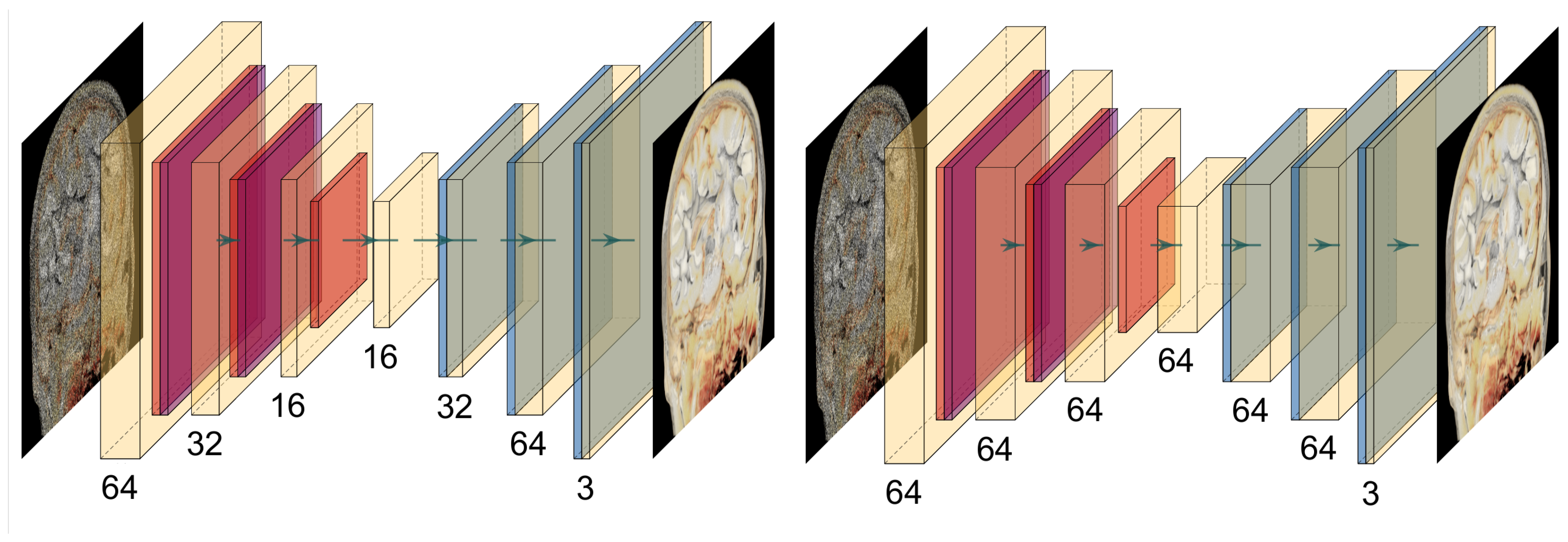

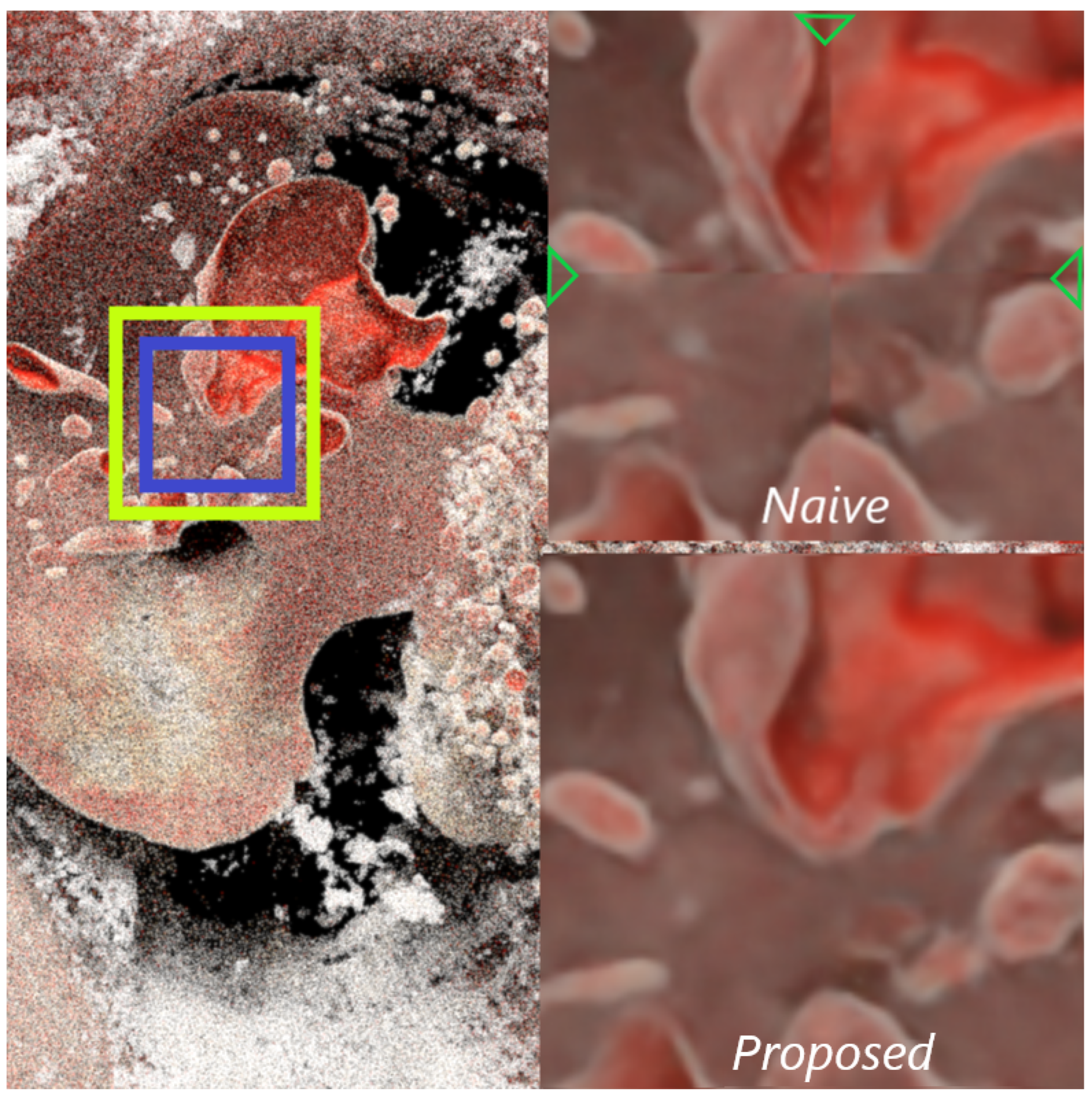

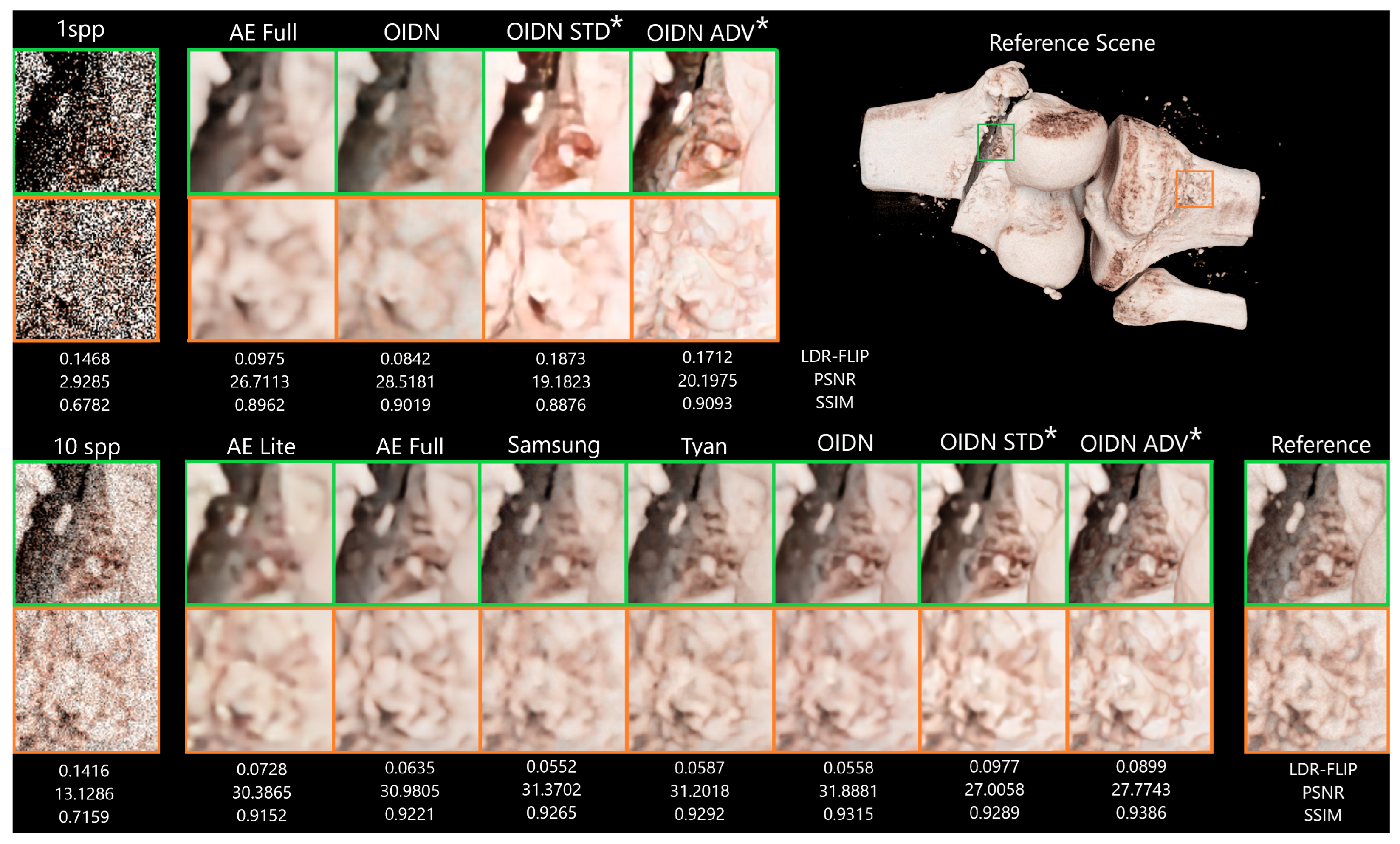
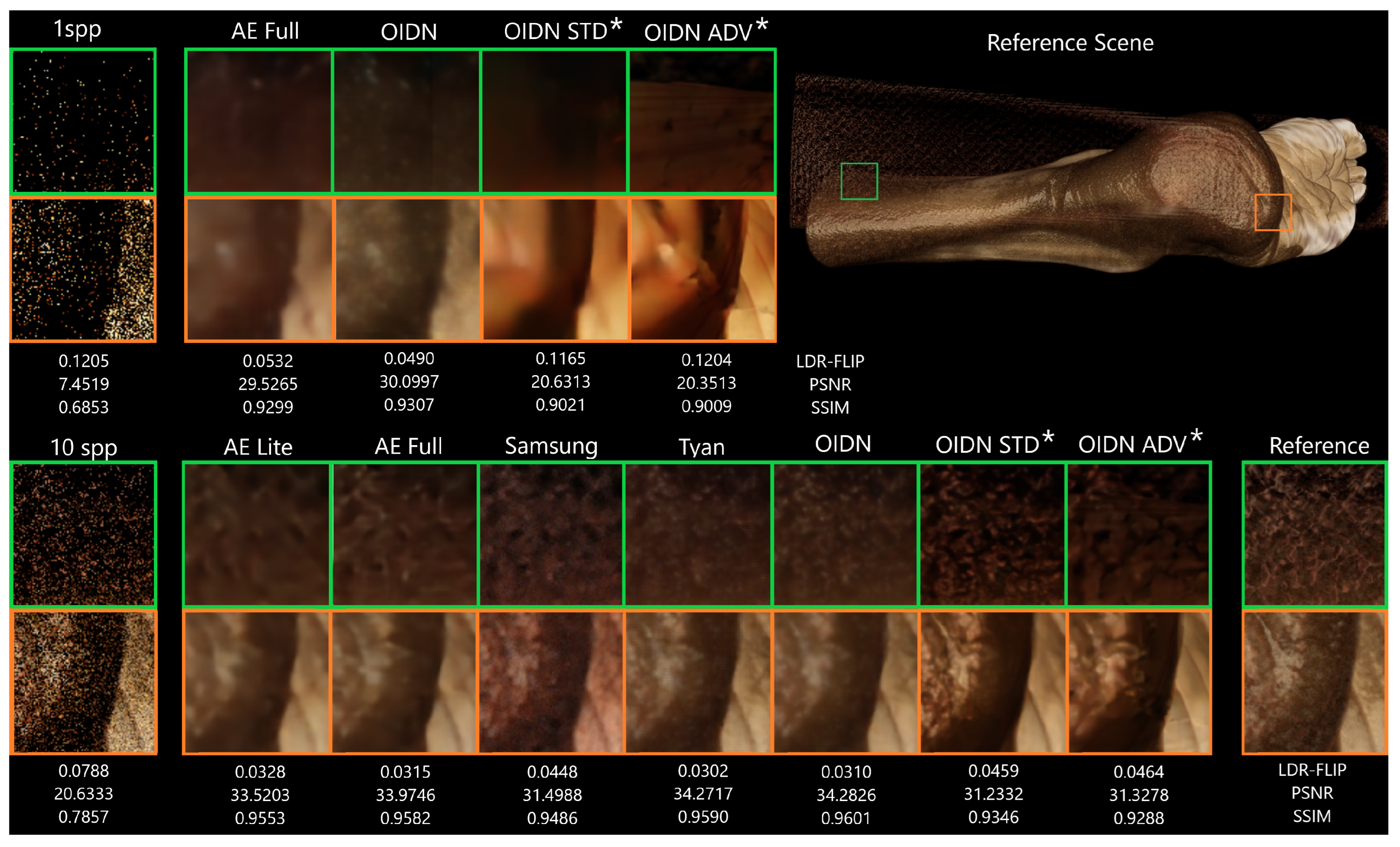

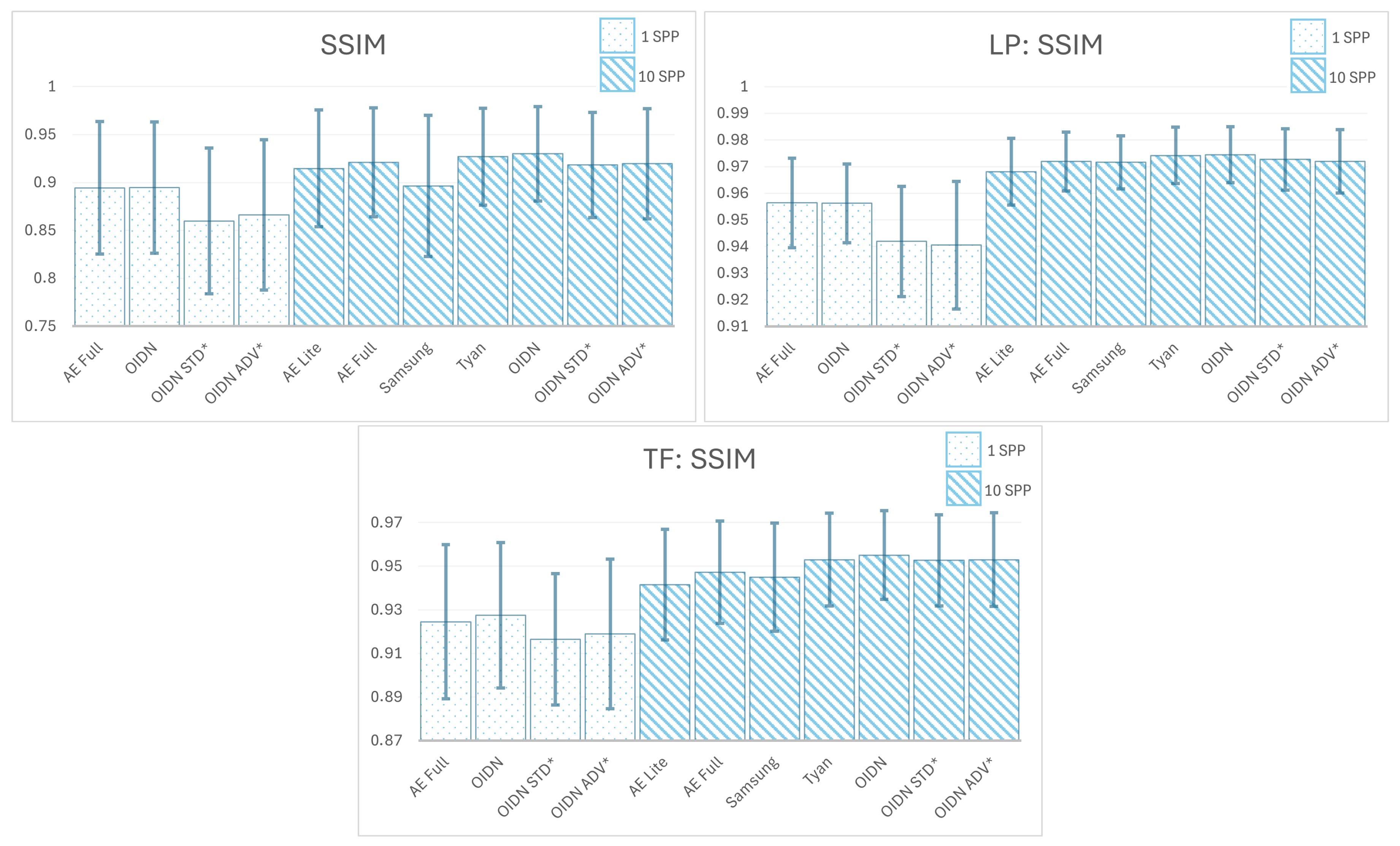

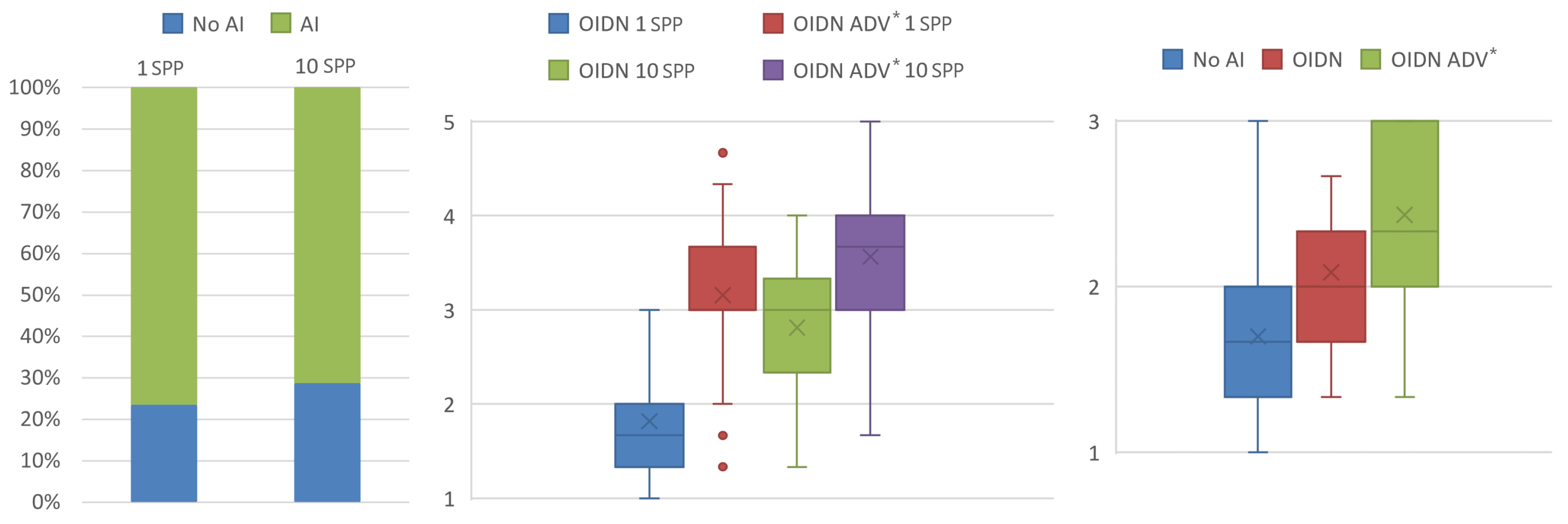

| Model | CPU (ms) | GPU (ms) | 1 SPP (FPS) | 10 SPP (FPS) |
|---|---|---|---|---|
| AE Lite | 1510 | 73 | 7.14 | 1.35 |
| AE Full | 1969 | 89 | 6.41 | 1.32 |
| Samsung | 28,374 | 1108 | 0.85 | 0.56 |
| Tyan | 28,214 | 1148 | 0.82 | 0.55 |
| OIDN | 6640 | 169 | 4.24 | 1.19 |
| OIDN STD* | 914 | N/A | 1.02 | 0.63 |
| OIDN ADV* | 956 | N/A | 0.98 | 0.62 |
| Model | Known TF, LP | Unknown LP | Unknown TF |
|---|---|---|---|
| LDR-FLIP (1 SPP) | |||
| AE Full | 0.1022 (0.0657) | 0.0413 (0.0156) | 0.0787 (0.0407) |
| OIDN | 0.1020 (0.0685) | 0.0401 (0.0143) | 0.0740 (0.0355) |
| OIDN STD* | 0.2572 (0.1448) | 0.0729 (0.0285) | 0.1584 (0.0656) |
| OIDN ADV* | 0.2685 (0.1604) | 0.0693 (0.0284) | 0.1551 (0.0672) |
| PSNR (1 SPP) | |||
| AE Full | 28.00 (3.17) | 30.15 (3.12) | 29.08 (4.31) |
| OIDN | 28.41 (2.82) | 30.05 (2.14) | 29.65 (3.28) |
| OIDN STD* | 19.02 (4.13) | 24.28 (2.99) | 21.61 (2.78) |
| OIDN ADV* | 18.78 (4.87) | 24.89 (3.03) | 22.09 (3.04) |
| SSIM (1 SPP) | |||
| AE Full | 0.8944 (0.0690) | 0.9564 (0.0168) | 0.9245 (0.0353) |
| OIDN | 0.8945 (0.0685) | 0.9562 (0.0148) | 0.9275 (0.0334) |
| OIDN STD* | 0.8598 (0.0761) | 0.9419 (0.0207) | 0.9164 (0.0301) |
| OIDN ADV* | 0.8661 (0.0784) | 0.9405 (0.0239) | 0.9189 (0.0343) |
| Model | Known TF, LP | Unknown LP | Unknown TF |
|---|---|---|---|
| LDR-FLIP (10 SPP) | |||
| AE Lite | 0.0739 (0.0506) | 0.0299 (0.0115) | 0.0510 (0.0237) |
| AE Full | 0.0733 (0.0459) | 0.0289 (0.0107) | 0.0499 (0.0217) |
| Samsung | 0.0963 (0.0801) | 0.0262 (0.0091) | 0.0600 (0.0341) |
| Tyan | 0.0625 (0.0398) | 0.0248 (0.0107) | 0.0423 (0.0174) |
| OIDN | 0.0639 (0.0413) | 0.0295 (0.0145) | 0.0419 (0.0174) |
| OIDN STD* | 0.1049 (0.0668) | 0.0265 (0.0104) | 0.0700 (0.0333) |
| OIDN ADV* | 0.1064 (0.0729) | 0.0268 (0.0106) | 0.0698 (0.0356) |
| PSNR (10 SPP) | |||
| AE Lite | 31.04 (2.98) | 32.58 (3.53) | 32.42 (2.67) |
| AE Full | 31.33 (2.92) | 32.77 (3.70) | 32.99 (2.59) |
| Samsung | 29.68 (3.43) | 34.11 (2.40) | 32.37 (2.77) |
| Tyan | 32.15 (3.00) | 34.20 (4.00) | 33.90 (2.86) |
| OIDN | 32.29 (3.05) | 33.08 (4.71) | 34.29 (2.75) |
| OIDN STD* | 29.07 (3.42) | 34.28 (2.85) | 30.98 (3.54) |
| OIDN ADV* | 29.27 (3.63) | 34.27 (2.97) | 31.24 (3.57) |
| SSIM (10 SPP) | |||
| AE Lite | 0.9146 (0.0608) | 0.9681 (0.0125) | 0.9415 (0.0254) |
| AE Full | 0.9210 (0.0567) | 0.9719 (0.0110) | 0.9472 (0.0235) |
| Samsung | 0.8964 (0.0736) | 0.9716 (0.0100) | 0.9449 (0.0248) |
| Tyan | 0.9269 (0.0506) | 0.9742 (0.0106) | 0.9530 (0.0213) |
| OIDN | 0.9299 (0.0492) | 0.9744 (0.0105) | 0.9551 (0.0203) |
| OIDN STD* | 0.9183 (0.0549) | 0.9727 (0.0115) | 0.9527 (0.0209) |
| OIDN ADV* | 0.9196 (0.0574) | 0.9719 (0.0119) | 0.9530 (0.0215) |
Disclaimer/Publisher’s Note: The statements, opinions and data contained in all publications are solely those of the individual author(s) and contributor(s) and not of MDPI and/or the editor(s). MDPI and/or the editor(s) disclaim responsibility for any injury to people or property resulting from any ideas, methods, instructions or products referred to in the content. |
© 2025 by the authors. Licensee MDPI, Basel, Switzerland. This article is an open access article distributed under the terms and conditions of the Creative Commons Attribution (CC BY) license (https://creativecommons.org/licenses/by/4.0/).
Share and Cite
Denisova, E.; Bocchi, L.; Nardi, C. Deep Learning-Based Denoising for Interactive Realistic Rendering of Biomedical Volumes. Appl. Sci. 2025, 15, 9893. https://doi.org/10.3390/app15189893
Denisova E, Bocchi L, Nardi C. Deep Learning-Based Denoising for Interactive Realistic Rendering of Biomedical Volumes. Applied Sciences. 2025; 15(18):9893. https://doi.org/10.3390/app15189893
Chicago/Turabian StyleDenisova, Elena, Leonardo Bocchi, and Cosimo Nardi. 2025. "Deep Learning-Based Denoising for Interactive Realistic Rendering of Biomedical Volumes" Applied Sciences 15, no. 18: 9893. https://doi.org/10.3390/app15189893
APA StyleDenisova, E., Bocchi, L., & Nardi, C. (2025). Deep Learning-Based Denoising for Interactive Realistic Rendering of Biomedical Volumes. Applied Sciences, 15(18), 9893. https://doi.org/10.3390/app15189893








